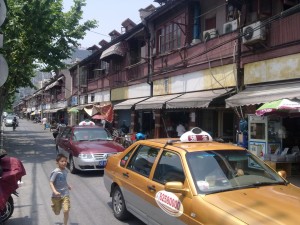Shanghai Street View: Drab Cabs

It may sound like a small and unimportant detail, but taxi cabs form one of the first and strongest impressions that people get when they travel to other cities. Cabs are equally significant for local residents, constituting part of the fabric of everyday life for many urban dwellers in their hometowns.
That’s why I was excited to read that after years of using the boxy and flimsy looking Volkswagen Santana for its taxi fleet, Shanghai was preparing to choose a replacement for the thousands of cabs that ply the city’s streets. According to the latest reports, Volkswagen’s small but much sportier Lavida is the prime candidate to replace Santanas, which have recently ceased production.
Before I go any further with my musings on the importance of taxi fleets in shaping a city’s identity, I should quickly slip into reverse and say that Shanghai easily has the best managed taxi fleet in China. Anyone who travels regularly to Beijing, Shanghai’s chief rival in many other respects, knows that taxis are one area where Shanghai is clearly the winner.
First and most importantly, it’s possible to hail a taxi in Shanghai at almost any time of day. Even during peak hours and rainy days, one can usually find a taxi within 15 or 20 minutes. By comparison, many people don’t even bother trying to hail a taxi in Beijing during rush hour, and even during off-peak hours they’re sometimes hard to find.
Beijing cabbies can also be a fickle bunch, sometimes refusing to take passengers to out-of-the-way destinations. In all my time in Shanghai I’ve never had that problem, and I suspect at least part of the reason is because cabbies are warned of strict punishment for refusing to take passengers where they want to go.
I won’t sing the praises of Shanghai’s taxi management too much more, as I don’t want to go overboard. But I was reminded of just how good the city’s taxi fleet was during a recent visit to Harbin, where cabs often stop to pick up new passengers when they are still delivering existing ones to other destinations.
All that said, let’s return to the latest news of Shanghai’s taxi overhaul, a move likely to shape the city’s urban landscape for at least the next decade. A few obstacles still stand in the Lavida’s way of being chosen as the city’s new standard bearer, mostly related to costs, according to the report I read.
While price is obviously important, I would strongly urge the city not to put too much emphasis on that single element and perhaps to even subsidize some of the added costs for drivers. My reasoning is simple: such an investment would be relatively small compared to the big returns of boosting the city’s image as a slick and modern financial hub.
To this day, one of my strongest images of Shanghai is its thousands of beaten-up Santanas that dominate the city’s roads. In some ways they seem like ants that find their way into every nook and cranny of your home. They look flimsy and unstylish from the outside, and are equally unattractive on the inside with their dirty cloth covers, uncomfortable seats and droning advertising screens.
By choosing a sportier car like the Lavida, the government could instantly make the city’s streets far more attractive. One need only look at nearby cities like Hong Kong and Taipei to see what a huge difference attractive taxis can make to an urban landscape. Hong Kong is practically synonymous with the hundreds of attractive red, Toyota Comfort taxis that ply its streets, while Taipei is equally attractive with a range of bright yellow models from Toyota and Nissan.
If I were advising Shanghai, I would also recommend an overhaul for cab interiors. That would begin with removal of the current cloth seat covers, and a requirement that all cabs include seat belts that are now absent in most back seats. I like the idea that cabbies should wear gloves, which adds a certain class and charm even though it doesn’t seem too common anymore. But dirty white gloves that look like they haven’t been washed for weeks are hardly attractive, which is what many cabbies often wore.
At the end of the day, the city should think long and hard before making its final decision about which car to choose for its next taxi fleet. While costs will inevitably be one of the biggest factors, forward-looking officials should consider more intangible elements like image and comfort in their decision. Such a decision might cost a little more in the short run, but could also help to narrow the image gap between Shanghai and more worldly cities like Hong Kong, Taipei and Tokyo.
